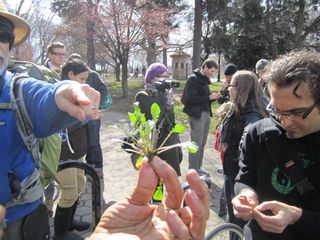Who Observed Variations In The Characteristics Of Animals And Plants
Spring Shows Earlier and Before for Many Plants, Animals

NEW YORK — A tiny, cloverlike plant with eye-shaped leaflets defenseless Steve Brill's attention as he scanned the ground of a Brooklyn park.
"We have really messed up our climate if this plant, which dies in November, is alive at present," Brill announced as he introduced the plant, yellow wood sorrel, to the group post-obit him.
Brill leads foraging tours for edible plants in the New York expanse, and his start tour of the 2012 flavour, in Prospect Park, yielded some surprises brought by the unusually mild winter. The lemony-flavored sorrel, for example, had shown up at least a month earlier than normal.
Sunday (March 4) marked the first tour of his 30th flavour. Brill said he has noticed a gradual shift in the annual cycle over the years, with many plants showing upwardly about three weeks before than they once did, and and then lasting much longer. This year is unprecedented — some plants never even died off for the winter, he said. [Gallery: Signs of Early on Jump in Brooklyn]
Changes in timing
Scientific evidence for similar shifts in timing amid all kinds of plants and animals is abundant. For example, studies bespeak lilacs in Due north America are leafing out and flowering before; in Japan, gingko trees are getting their first leaves earlier and losing them later; bee species in the northeastern North America are emerging earlier, keeping footstep with the flowers upon which they feed; British collywobbles are also showing upward sooner; and birds appear to exist shifting the timing of their migrations.
One study even looked at National Park omnipresence to find prove of a similar shift in seasonal timing — called phenology — for humans.
"There is a study coming out every calendar week showing changes are occurring," said Jake Weltzin, the executive manager of the USA National Phenology Network and an ecologist with U.South. Geological Survey, which recruits volunteers to monitor seasonal changes in plants and animals.
Attributing these changes directly to global climate modify is more difficult, but researchers are starting time to practise just that; they're finding prove that shifts in climate are directly linked to changes in the timing of biological events, Weltzin said.
Consequences
Changes in the timing of events such as jump blooms, insect emergence and bird migrations have consequences.
First of all, non all species respond in the same fashion; some are amend able to adapt than others. This means mismatches can occur, if, say, bees and the flowering plants they pollinate don't respond at the same rate. Mismatches similar this can affect the prospects of the species involved.
"It is going to rig the game for certain species and the ones that are successful, it is going to alter the individuals within them," said Mark Schwartz, a distinguished professor of geography and climate at the University of Wisconsin-Milwaukee. "It is an evolutionary process."
The fingerprint of climate change
Schwartz studies how plants respond to changes in seasons and climate, drawing upon observations of plants made by volunteers. With records of the first appearance of their leaves and flowers going back to 1956, lilacs — all of which are genetically identical to minimize variation among them — have the longest record.
Using observations from the lilacs, too every bit cloned honeysuckle, Schwartz has congenital models to fill in the gaps in the data to predict how temperature might affect the inflow of spring leaves and blooms.
Using this technique, Schwartz and colleagues have shown that first leafage and bloom dates crept ahead past around 1 day per decade betwixt 1955 and 2002 across most Northern Hemisphere temperate regions. Other studies that take assessed data on many species take besides constitute temperature-related shifts in jump.
His jump plant models have also been used to look at how natural patterns, such as cycles in atmospheric pressure and ocean temperature, play into earlier springs. [What'south Causing Early Jump?]
"The statement seems compelling from what I have seen, that nosotros are in a longer-term trend toward things existence quite different," Schwartz said.
You lot can follow LiveScience senior writer Wynne Parry on Twitter @Wynne_Parry . Follow LiveScience for the latest in science news and discoveries on Twitter @livescience and on Facebook .
Source: https://www.livescience.com/18912-early-spring-plants-animals-climate.html
Posted by: bojorqueznothat.blogspot.com

0 Response to "Who Observed Variations In The Characteristics Of Animals And Plants"
Post a Comment